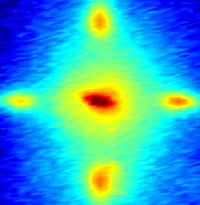
Are films ferroelectric?
Discipline for gold nanocrystals
Photosynthetic systems
Dissecting the atom
Catalytic clues
SAXS and the water channel
Digging in the dirt
Folding Protein Sensors
X-ray movies
Are films ferroelectric?
David Bradley is currently working with Argonne National Laboratory on a series of articles for the annual report of the ANL's Advanced Photon Source. For December's Elemental Discoveries, I will be offering a preview of the advanced science featured in the report.

Are films ferroelectric?
Discipline for gold nanocrystals
Photosynthetic systems
Dissecting the atom
Catalytic clues
SAXS and the water channel
Digging in the dirt
Folding Protein Sensors
X-ray movies
Are films ferroelectric?
Thin films of ferroelectric material for use in future "electronic" devices
can be as thin as developers desire without loss of function according to a
synchrotron x-ray study carried out by researchers using the BESSRC/XOR
beamline 12-ID at the APS. The results show that a thin film of one
particular ferroelectric material, lead titanate, is still stable even in a
layer a mere 1.2 nanometers thin.
 An
electric field can control the permanent polarization in a ferroelectric
material in much the same way that a magnetic field controls the
magnetization of a ferromagnet. Ferroelectric materials known as perovskites,
of which lead titanate is one, share their crystal structure with the
mineral perovskite, and are being keenly investigated by researchers for new
applications in microelectronics.
An
electric field can control the permanent polarization in a ferroelectric
material in much the same way that a magnetic field controls the
magnetization of a ferromagnet. Ferroelectric materials known as perovskites,
of which lead titanate is one, share their crystal structure with the
mineral perovskite, and are being keenly investigated by researchers for new
applications in microelectronics.
Ferroelectric materials are already being used in microelectronic devices,
such as non-volatile random access memory (NVRAM) that exploit
ferroelectricity to store information. An electric field would switch the
permanent polarization from one direction to the other, representing the
switch from a 0 bit of information to a 1. The development of NVRAM could
provide computers and ever-smaller portable information devices with
high-density solid-state memory that, unlike conventional RAM, do not lose
their information when switched off. The Argonne research removes a
potential limitation on how dense these devices could be.
Perovskites also have other potentially useful properties. They are
piezoelectric materials, for instance, changing shape when a voltage is
applied or generating a voltage when they are deformed. They are also
pyroelectric, producing a voltage when the temperature changes.
Electronically controlled switches, valves, pumps, and sensors in so-called
lab-on-a-chip devices, or microelectromechanical systems (MEMS), could
exploit such properties.
Technologists hoping to exploit the novel electrical and magnetic properties
of such advanced materials in thin film form have often encountered problems
maintaining the properties in very thin films. Researchers found that films
of lead titanate thinner than 100 nanometers for instance had reduced
polarizability and sometimes exhibited no ferroelectric behavior at all. If
this problem proved to be the result of a fundamental incompatibility
between ferroelectricity and reduced thickness, it might present a lower
limit on the size of microelectronic components based on such materials.
Researchers from the Materials Science Division, at Argonne National
Laboratory, and the Department of Physics at Northern Illinois University in
DeKalb, were not convinced that the size effects seen in previous studies
would arise in all ferroelectric samples. It can be very difficult to
separate the effects of true size dependence from those of uncontrolled
experimental variables such as stress and composition that can vary with
sample size, team leader Brian Stephenson explains. Recent theoretical
calculations carried out by other researchers had also predicted that
perovskite films would still have ferroelectric properties even in thin
films just a few nanometers thick.
The Argonne and Northern Illinois team set about making detailed
experimental observations that would unambiguously settle the long-standing
question of the thickness limit for ferroelectricity. The team used
metalorganic chemical vapor deposition to grow thin layers of the perovskite
lead titanate on single crystals of strontium titanate. By carrying out
x-ray scattering experiments during the deposition process they were able to
control the thickness of the layer very precisely to an integer value of the
crystal's so-called unit cell. Using this in situ approach and the
high-brilliance synchrotron x-ray beam from the APS, the team obtained
accurate data from high-quality samples as thin as one unit cell.
In these thin films, the ferroelectric phase forms in nanometer-scale
stripes of alternating polarity which produce characteristic signals,
satellite peaks, in the x-ray scattering results. The researchers used these
satellite peaks to identify the ferroelectric phase. Fig. 1 shows the
scattering pattern from a 3 unit cell (1.2 nanometer) thick film; it reveals
that it is ferroelectric. The team found thinner (2 and 1 unit cell thick)
films to be non-ferroelectric. This tiny thickness limit for
ferroelectricity bodes well for making sub-microscopic layers for use in
various novel applications, say the researchers.
Source: Dillon D. Fong1, G. Brian Stephenson1, Stephen K. Streiffer1,
Jeffrey A. Eastman1, Orlando Auciello1, Paul H. Fuoss1, and Carol Thompson2,
"Ferroelectricity in Ultrathin Perovskite Films," Science 304 (5677),
1650-1653, 11 June 2004).
Back to the December elemental discoveries index page